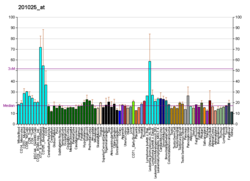Protein-coding gene in the species Homo sapiens
Eukaryotic translation initiation factor 5B is a protein that in humans is encoded by the EIF5B gene .[ 5] [ 6] [ 7] bacterial initiation factor 2 , sharing a core structure while their involvement in translation initiation differs.[ 8]
eIF5B plays an important role in later stages of the translation initiation mechanism. After the start codon has been engaged by the scanning initiation complex, eukaryotic initiation factors eIF1 , eIF2 , and eIF5 leave the ribosome . Subsequently, eIF5B-GTP is recruited to the ribosome. eIF1A induces rotation of a domain of eIF5B-GTP, which in turn positions the initiator tRNA such that joining of the large ribosomal subunit is possible.[ 9] [ 10] [ 11]
^ a b c GRCh38: Ensembl release 89: ENSG00000158417 – Ensembl , May 2017^ a b c GRCm38: Ensembl release 89: ENSMUSG00000026083 – Ensembl , May 2017^ "Human PubMed Reference:" . National Center for Biotechnology Information, U.S. National Library of Medicine .^ "Mouse PubMed Reference:" . National Center for Biotechnology Information, U.S. National Library of Medicine .^ Lee JH, Choi SK, Roll-Mecak A, Burley SK, Dever TE (May 1999). "Universal conservation in translation initiation revealed by human and archaeal homologs of bacterial translation initiation factor IF2" . Proc Natl Acad Sci U S A . 96 (8): 4342– 7. Bibcode :1999PNAS...96.4342L . doi :10.1073/pnas.96.8.4342 PMC 16334 PMID 10200264 . ^ Wilson SA, Sieiro-Vazquez C, Edwards NJ, Iourin O, Byles ED, Kotsopoulou E, Adamson CS, Kingsman SM, Kingsman AJ, Martin-Rendon E (Oct 1999). "Cloning and characterization of hIF2, a human homologue of bacterial translation initiation factor 2, and its interaction with HIV-1 matrix" . Biochem J . 342. ( Pt 1) (Pt 1): 97– 103. doi :10.1042/bj3420097 . PMC 1220441 PMID 10432305 . ^ "Entrez Gene: EIF5B eukaryotic translation initiation factor 5B" .^ Unbehaun, Anett; Marintchev, Assen; Lomakin, Ivan B.; Didenko, Tatyana; Wagner, Gerhard; Hellen, Christopher U T.; Pestova, Tatyana V. (2007). "Position of eukaryotic initiation factor eIF5B on the 80S ribosome mapped by directed hydroxyl radical probing" . The EMBO Journal . 26 (13): 3109– 3123. doi :10.1038/sj.emboj.7601751 . PMC 1914099 PMID 17568775 . ^ Lapointe, Christopher P.; Grosely, Rosslyn; Sokabe, Masaaki; Alvarado, Carlos; Wang, Jinfan; Montabana, Elizabeth; Villa, Nancy; Shin, Byung-Sik; Dever, Thomas E.; Fraser, Christopher S.; Fernández, Israel S.; Puglisi, Joseph D. (2022). "EIF5B and eIF1A reorient initiator tRNA to allow ribosomal subunit joining" . Nature . 607 (7917): 185– 190. Bibcode :2022Natur.607..185L . doi :10.1038/s41586-022-04858-z . PMC 9728550 PMID 35732735 . ^ Fringer, Jeanne M.; Acker, Michael G.; Fekete, Christie A.; Lorsch, Jon R.; Dever, Thomas E. (2007). "Coupled Release of Eukaryotic Translation Initiation Factors 5B and 1A from 80S Ribosomes following Subunit Joining" . Molecular and Cellular Biology . 27 (6): 2384– 2397. doi :10.1128/MCB.02254-06 . PMC 1820483 PMID 17242201 . ^ Wang, Jinfan; Wang, Jing; Shin, Byung-Sik; Kim, Joo-Ran; Dever, Thomas E.; Puglisi, Joseph D.; Fernández, Israel S. (2020). "Structural basis for the transition from translation initiation to elongation by an 80S-eIF5B complex" . Nature Communications . 11 (1) 5003. Bibcode :2020NatCo..11.5003W . doi :10.1038/s41467-020-18829-3 . PMC 7538418 PMID 33024099 .
A comprehensive review on eukaryotic translation initiation : Brito Querido, Jailson; Díaz-López, Irene; Ramakrishnan, V. (2024). "The molecular basis of translation initiation and its regulation in eukaryotes" . Nature Reviews Molecular Cell Biology . 25 (3): 168– 186. doi :10.1038/s41580-023-00624-9 . PMID 38052923 . The structure of an 80S-eIF5B complex : Wang, Jinfan; Wang, Jing; Shin, Byung-Sik; Kim, Joo-Ran; Dever, Thomas E.; Puglisi, Joseph D.; Fernández, Israel S. (2020). "Structural basis for the transition from translation initiation to elongation by an 80S-eIF5B complex" . Nature Communications . 11 5003. Bibcode :2020NatCo..11.5003W . doi :10.1038/s41467-020-18829-3 . PMID 33024099 . Marintchev A, Kolupaeva VG, Pestova TV, Wagner G (2003). "Mapping the binding interface between human eukaryotic initiation factors 1A and 5B: a new interaction between old partners" . Proc. Natl. Acad. Sci. U.S.A . 100 (4): 1535– 40. Bibcode :2003PNAS..100.1535M . doi :10.1073/pnas.0437845100 PMC 149867 PMID 12569173 . Olsen DS, Savner EM, Mathew A, et al. (2003). "Domains of eIF1A that mediate binding to eIF2, eIF3 and eIF5B and promote ternary complex recruitment in vivo" . EMBO J . 22 (2): 193– 204. doi :10.1093/emboj/cdg030 . PMC 140105 PMID 12514125 .






